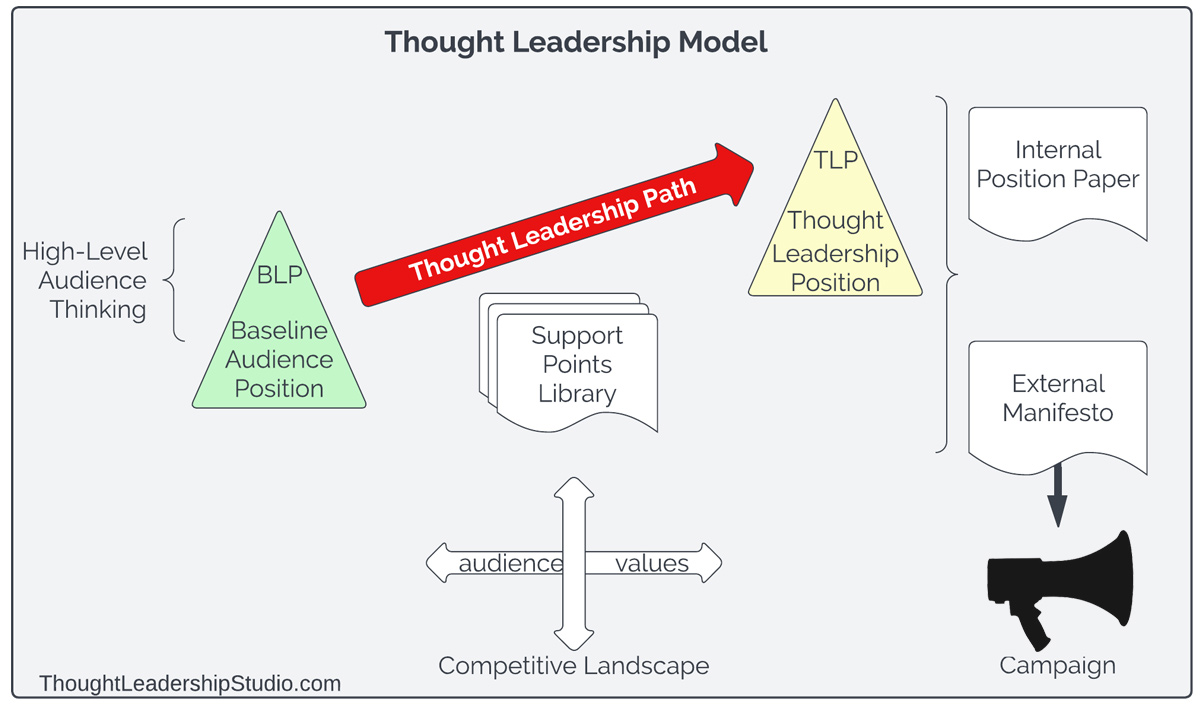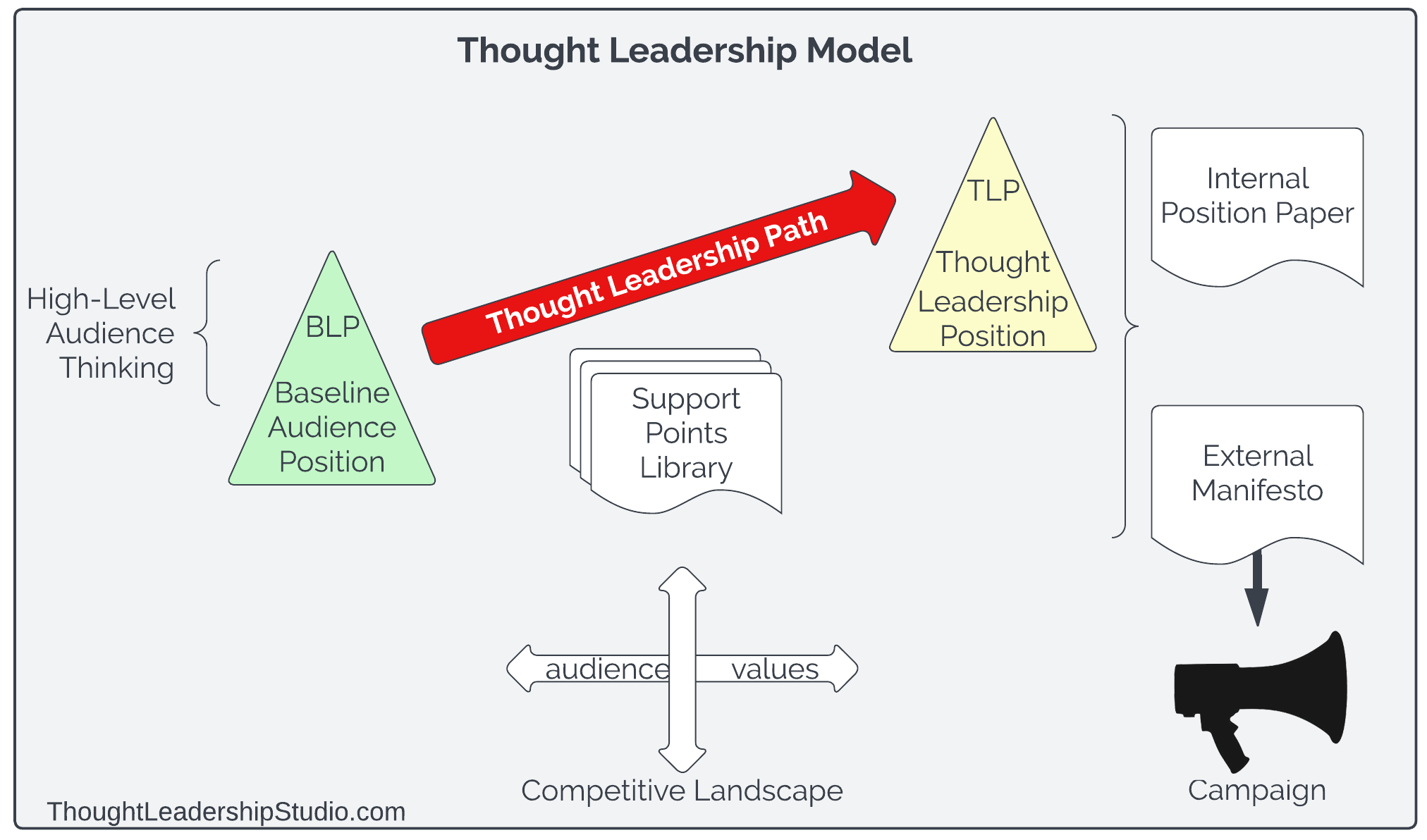Thought Leadership Studio Blog Posts:
The 9 Building Blocks of a Thought Leadership Model
Building a robust Thought Leadership Model is like a construction project. The structure needs to be complete, and this includes the parts that aren't visible in the end product.

#contentmarketing, #entrepreneurship, #faqs, #infographics, #marketing, #marketingstrategy, #strategicthoughtleadership, #thoughtleadership, #thoughtleadershipmarketing, #thoughtleadershipmodel, #workshop
There is a structure.
 Building a robust Thought Leadership Model is like a construction project. The structure needs to be complete, and this includes the parts that aren't visible in the end product.
Building a robust Thought Leadership Model is like a construction project. The structure needs to be complete, and this includes the parts that aren't visible in the end product.
Imagine a general contractor building a luxury house on a narrow peninsula. On his initial visit to the lot, against an orange and red dappled sunset framing green marsh, he feels the softness of the ground under his boots. He notes he will have to drive the pilings deep to ensure the building doesn't sink or tilt.
In a flurry of activity spiced with the scents of wet paint and sawdust, he conducts an orchestra of hammering nails, pounding pillars, and swishing paintbrushes. Every aspect - inside and out - has to be properly attended to.
So it is with building an effective thought leadership campaign.
We want the confidence that even the hidden components were properly addressed in the building process. It needs a deep, well-anchored foundation.
More than Expertise.
 I've seen thought leadership described as simply being seen as an expert in your field. This has apparently led many to believe the aim of thought leadership is to be perceived as knowledgeable.
I've seen thought leadership described as simply being seen as an expert in your field. This has apparently led many to believe the aim of thought leadership is to be perceived as knowledgeable.
Yet just being recognized for expertise is like the paint on the house. It might look nice at first glance, but it doesn't go deep.
If this is all you do, you might appear smart, but your audience won't care. Instead build a structure that moves high-level audience thinking for the most profound, positive impact. I will explain what I mean by high-level thinking further on.
Thought leadership isn't simply about showing what you know, it's about empowering your audience to get more out of what you offer.
I often ask leaders to back up and take in a broader perspective that includes how people use what they offer. When they consider how their expertise enhances their audience's experience, that improved experience comes into clearer focus as the true purpose of their thought leadership.
It's not just about how much you know, it's about how well you package and apply what you know to empower your audience to get more value, make a smarter buying decision, or elevate the purpose of using what you offer.
Do you remember that in classical times when Cicero had finished speaking, the people said, "How well he spoke" but when Demosthenes had finished speaking, they said, "Let us march."
- Adlai Stevenson, introducing John F. Kennedy in 1960(1)
So, knowing that we want to have high-level positive impact on an audience, we need to create the proper instrument of Strategic Thought Leadership: a Thought Leadership Model.
A Thought Leadership Model has multiple components.
Peeling the Layers of the Onion
From the thousand feet perspective, we can list the building blocks this way:
Components of a Thought Leadership Model
- Awareness of High-Level Audience Thinking: Your target segment's related (or potentially related) Values, Beliefs, Identity, and Core Purpose.
- Knowledge of the Competitive Landscape (of ideas and market/service positions)- in audience terms.
- The Audience Baseline Position you are leading people away from.
- A well-formulated Thought Leadership Position as a destination to lead an audience to.
- The Audience Baseline Position and Thought Leadership Position define the starting and end points of a clear Thought Leadership Path.
- A set of supporting talking points, AKA Support Points,
- An internal Position Paper summarizing the Thought Leadership Path along with the Support Points that undermine the old thinking and support the new thinking.
- An external Thought Leadership Manifesto as a centerpiece of your position, utilizing the Support Points as persuasive arguments.
- A PR, content, or marketing Campaign that engages an audience to lead along the Thought Leadership Path
Awareness of High-Level Audience Thinking
The Thaut Process 7 Levels of Change and Influence Model illuminates higher levels of influence than adding knowledge or skills. The 7 Levels are:
- Core Purpose: The highest positive related mission.
- Identity: The sense of "who am I" in relation to your product, service, field, or profession.
- Values: What's important? ... in terms of feelings. Higher Values are more universal, positive, and immutable. We could even evoke Jung's concept of archetypes for them.
- Mental Models: Our maps of the world. What does your audience believe about what you offer? How do they see its place in their lives?
- Skillset: What are your prospects' abilities to use what you sell? What are their relevant knowledge and skills?
- Pull: Expressed customer demand for what you offer, like spending money for it.
- Pullfillment: The experience of the customer using the product or service. Click here for more on Pullfillment.
Some "thought leaders" aim purely at the Skillset level: increasing an audience's knowledge about a subject. Yet, there is more impact in influencing or aligning with higher levels.
Higher levels = higher impact.
A common high-level influence strategy in Strategic Thought Leadership is to align with unmet higher values by influencing on the level of mental models. Put more simply, it is helping an audience satisfy what is important to them by leading them to a more empowering belief about your product, service, field, or profession.
Click here to learn more about the 7 Levels of Change and Influence Model.
Knowledge of the Competitive Landscape.
It isn't just the thinking of your audience that is an issue, it is also the thinking and positioning of your competitors. What are the common assumptions of your field, market segment, or profession? Is there an opening to better satisfy higher values in the customer base or audience than those assumptions allow for?
While the primary focus is leading an audience's thinking, it helps to open up your awareness of the "status quo" as supported by the prevalent models of a field, industry, niche, or profession. You might want to make a clear break from common assumptions.
The competitive landscape is often best represented as a 4-quadrant model with x and y axes representing two key variables. I have found it helpful to have at least 2 such competitive charts:
- the first charting typical market variables like pricing and distribution.
- The second charting how well you or your business and your competitors meet important audience values discovered that relate - or could relate - to your offering or position.
Knowledge of your Audience Baseline Position.
What is the old thinking you are aiming to replace with something better? Using the 7 Levels Model referenced above, this is defined on the Mental Models level. Insights into stale audience thinking that is ready for an overhaul can emerge from knowing both the competitive landscape and high-level audience thinking.
Then you can contrast this less-than-ideal mental model with...
A well-formulated Thought Leadership Position.
The Thought Leadership Position or TLP is a statement of the new thinking you are leading an audience to. Ideally, it satisfies higher values in your audience. It represents a new mental model or belief that is more empowering than their current way of seeing your field, profession, product, or service. It offers a fresh perspective that helps them:
- Extract more value,
- See it in a new light,
- Make smarter purchase decisions, or
- Elevate its use to a higher purpose,
.
A clear Thought Leadership Path.
The thought leadership path includes the beginning point of where the audience starts and the destination of where you are taking them. These two end points of the vector are defined in two ways:
- Origin & destination thinking.
- Origin and destination states including emotions.
It is important to remember these two concurrent tracks of persuasion. People make decisions based on emotion, so they respond to being led to the better feelings your Thought Leadership Position will give.. They also need to support emotion-based decisions with logic, and that side is covered by the Support Points that convince the rational mind.
The Thought Leadership Path is a bridge from old thinking to new. Then the question becomes, how to propel an audience along this bridge? The starting point of this positive persuasion is creating ...
A set of persuasive Support Points.
 These Support Points are well-formulated talking points engineered to :
These Support Points are well-formulated talking points engineered to :
- Loosen the hold of the Audience Baseline Position
- Strengthen and Support the Thought Leadership Position
These Support Points, properly engineered and implemented, propel an audience along the Thought Leadership Path.
NLP (Neuro-Linguistic Programming) is rich with methods for developing persuasive talking points that can help an audience expand and enrich their mental models. And, even after an audience member has expanded their world-view to include your Thought Leadership Position, they still have their old Audience Baseline Position available to them, should they choose to return to it as their working model of the world. You have only added a new choice, rather than taking anything away. Properly implemented, Strategic Thought Leadership increases freedom.
Construct your Thought Leadership Model well, as people will generally always choose the available mental model that is most advantageous to them.
The ever-growing library of Support Points connects the Audience Baseline Position and Thought Leadership Position so they together form the content of...
An internal Position Paper.
This not-for-public-view document outlines the back-story of thought leadership to inform all of your thought leadership communications.
It outlines the thrust, direction, and arguments in favor of your Thought Leadership Path. It expedites and informs content marketing, advertising, or public relations campaigns.
Speaking of which, this internal document also has a powerful public counterpart in the form of..
An external Thought Leadership Manifesto.
The Thought Leadership Manifesto could be contained within many formats, including:
- A Book.
- A website.
- An eBook or series of eBooks.
- A podcast.
- A video channel.
- A scripted speech.
- Any combination of the above, or other media..
No matter what container holds it, what makes this well-organized model a manifesto is that it contains all the relevant components of your Thought Leadership Model. It is designed to propel audience thinking forward in a way that empowers them and casts you or your organization in the best possible light at the same time.
What's the best way to cast you or your organization in the best possible light? Empower your audience at the highest level possible with your manifesto. It utilizes the law of giving and receiving.
And once you have your Thought Leadership Position, enlivened by Support Points, encapsulated in the right container to form your Thought Leadership Manifesto, it is time to bring it to life with...
A PR, content, or marketing Campaign.
Your Thought Leadership Campaign utilizes media to bring your message to the right people, eloquently and at enough frequency to positively impact the thinking of a critical mass of people.
Vehicles you can utilize for your campaign can include:
- Being a guest on podcasts.
- Driving traffic to your website with SEO or pay-per-click.
- An email newsletter.
- Social media.
- Influencers or other third-party endorsements.
- Any combination of the above.

Being a Thought Leader Means Building and Implementing a Great Thought Leadership Model.
So it isn't about declaring yourself a thought leader. It isn't about promoting your business as a thought leading business.
It isn't even about demonstrating superior expertise or skills.
It is about creating and promoting a complete model of positive influence that brings your vision of an empowered, enraptured audience fully to life: a robust Thought Leadership Model.
***************************************